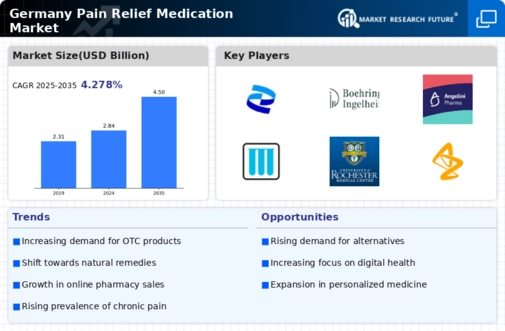Regulatory Changes and Market Access
Regulatory changes in Germany are influencing the dynamics of the pain relief-medication market. The German Medicines Act and recent amendments have streamlined the approval process for new medications, potentially expediting market access for innovative pain relief therapies. This regulatory environment encourages pharmaceutical companies to invest in the development of new pain management solutions, as they can bring products to market more efficiently. Additionally, the introduction of health technology assessments (HTAs) is shaping the reimbursement landscape, impacting the accessibility of pain relief medications for patients. As healthcare providers navigate these regulatory frameworks, the pain relief-medication market may see an influx of new products that meet the evolving needs of patients. This trend suggests a more competitive market landscape, with a wider array of options available for effective pain management.
Rising Awareness of Pain Management Options
There is a notable increase in awareness regarding pain management options among the German population, which is positively impacting the pain relief-medication market. Educational campaigns and healthcare initiatives have contributed to a better understanding of chronic pain and available treatment modalities. As patients become more informed, they are more likely to seek appropriate pain relief solutions, including both pharmacological and non-pharmacological approaches. This heightened awareness is reflected in the growing sales of pain relief medications, which have seen an increase of approximately 7% in recent years. Additionally, healthcare professionals are increasingly emphasizing the importance of comprehensive pain management strategies, which may include medications, physical therapy, and lifestyle modifications. This trend suggests a shift towards a more holistic approach to pain management, further driving the demand for diverse pain relief options.
Increasing Prevalence of Chronic Pain Conditions
The rising incidence of chronic pain conditions in Germany is a pivotal driver for the pain relief-medication market. Conditions such as arthritis, fibromyalgia, and neuropathic pain are becoming more prevalent, affecting a significant portion of the population. According to recent health statistics, approximately 20% of adults in Germany report experiencing chronic pain, which necessitates effective pain management solutions. This growing patient demographic is likely to increase the demand for various pain relief medications, including both prescription and over-the-counter options. As healthcare providers seek to address these conditions, the pain relief-medication market is expected to expand, with a projected growth rate of around 5% annually over the next few years. This trend underscores the importance of developing innovative and effective pain management therapies to cater to the needs of this expanding patient base.
Aging Population and Its Impact on Pain Management
Germany's aging population is a significant factor influencing the pain relief-medication market. As the demographic shifts towards an older age group, the prevalence of age-related ailments, such as osteoarthritis and other musculoskeletal disorders, is likely to rise. The Federal Statistical Office of Germany indicates that by 2030, nearly 30% of the population will be over 65 years old. This demographic is particularly susceptible to chronic pain, thereby driving the demand for effective pain relief medications. The pain relief-medication market must adapt to this growing need by offering targeted therapies that address the specific pain management requirements of older adults. Furthermore, the healthcare system may need to allocate more resources towards pain management strategies, which could further stimulate market growth in this sector.
Advancements in Pharmaceutical Research and Development
Innovations in pharmaceutical research and development are playing a crucial role in shaping the pain relief-medication market. The emergence of new drug formulations and delivery systems, such as transdermal patches and extended-release formulations, is enhancing the efficacy and safety profiles of pain relief medications. German pharmaceutical companies are investing heavily in R&D to develop novel analgesics that target specific pain pathways, potentially leading to more effective treatments with fewer side effects. This focus on innovation is expected to drive market growth, as healthcare providers and patients seek advanced pain management solutions. Furthermore, the introduction of biologics and personalized medicine approaches may revolutionize the treatment landscape, offering tailored therapies that address individual patient needs. As a result, the pain relief-medication market is likely to experience significant advancements in the coming years.























Leave a Comment